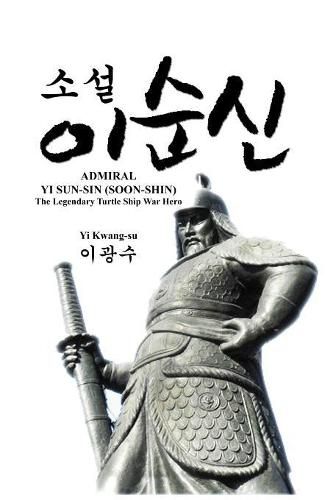Readings Newsletter
Become a Readings Member to make your shopping experience even easier.
Sign in or sign up for free!
You’re not far away from qualifying for FREE standard shipping within Australia
You’ve qualified for FREE standard shipping within Australia
The cart is loading…






This title is printed to order. This book may have been self-published. If so, we cannot guarantee the quality of the content. In the main most books will have gone through the editing process however some may not. We therefore suggest that you be aware of this before ordering this book. If in doubt check either the author or publisher’s details as we are unable to accept any returns unless they are faulty. Please contact us if you have any questions.
In 1592, with an army of approximately 158,000 troops, Toyotomi Hideyoshi launched what would end up being the first of two invasions of Korea, with the intent of conquering Joseon Korea and eventually Ming-dynasty China. Initially, the Japanese forces saw overwhelming success on land, capturing both Hanseong, the capital of Korea, and Pyongyang, and completing the occupation of large portions of the Korean Peninsula in three months. The Japanese forces, well trained, confident, and experienced after the numerous battles and conflicts of the Sengoku period, typically held the field in most land engagements. At the brink of the country falling to the Japanese forces, Joseon releases admiral Yi Sun-sin, the falsely-accused hero, from a prison cell, with the mission to save the nation. While all the bureaucrats begging to surrender, admiral Yi Sun-sin rejects the idea because he still has thirteen ships, including the legendary secret naval vessel, Geobukseon (turtle ship), to face one hundred and thirty three Japanese battle ships fast approaching the Korean Peninsula… Can admiral Yi Sun-sin save the nation?In 1592, with an army of approximately 158,000 troops, Toyotomi Hideyoshi launched what would end up being the first of two invasions of Korea, with the intent of conquering Joseon Korea and eventually Ming-dynasty China. Initially, the Japanese forces saw overwhelming success on land, capturing both Hanseong, the capital of Korea, and Pyongyang, and completing the occupation of large portions of the Korean Peninsula in three months. The Japanese forces, well trained, confident, and experienced after the numerous battles and conflicts of the Sengoku period, typically held the field in most land engagements. At the brink of the country falling to the Japanese forces, Joseon releases admiral Yi Sun-sin, the falsely-accused hero, from a prison cell, with the mission to save the nation. While all the bureaucrats begging to surrender, admiral Yi Sun-sin rejects the idea because he still has thirteen ships, including the legendary secret naval vessel, Geobukseon (turtle ship), to face one hundred and thirty three Japanese battle ships fast approaching the Korean Peninsula… Can admiral Yi Sun-sin save the nation?
$9.00 standard shipping within Australia
FREE standard shipping within Australia for orders over $100.00
Express & International shipping calculated at checkout
This title is printed to order. This book may have been self-published. If so, we cannot guarantee the quality of the content. In the main most books will have gone through the editing process however some may not. We therefore suggest that you be aware of this before ordering this book. If in doubt check either the author or publisher’s details as we are unable to accept any returns unless they are faulty. Please contact us if you have any questions.
In 1592, with an army of approximately 158,000 troops, Toyotomi Hideyoshi launched what would end up being the first of two invasions of Korea, with the intent of conquering Joseon Korea and eventually Ming-dynasty China. Initially, the Japanese forces saw overwhelming success on land, capturing both Hanseong, the capital of Korea, and Pyongyang, and completing the occupation of large portions of the Korean Peninsula in three months. The Japanese forces, well trained, confident, and experienced after the numerous battles and conflicts of the Sengoku period, typically held the field in most land engagements. At the brink of the country falling to the Japanese forces, Joseon releases admiral Yi Sun-sin, the falsely-accused hero, from a prison cell, with the mission to save the nation. While all the bureaucrats begging to surrender, admiral Yi Sun-sin rejects the idea because he still has thirteen ships, including the legendary secret naval vessel, Geobukseon (turtle ship), to face one hundred and thirty three Japanese battle ships fast approaching the Korean Peninsula… Can admiral Yi Sun-sin save the nation?In 1592, with an army of approximately 158,000 troops, Toyotomi Hideyoshi launched what would end up being the first of two invasions of Korea, with the intent of conquering Joseon Korea and eventually Ming-dynasty China. Initially, the Japanese forces saw overwhelming success on land, capturing both Hanseong, the capital of Korea, and Pyongyang, and completing the occupation of large portions of the Korean Peninsula in three months. The Japanese forces, well trained, confident, and experienced after the numerous battles and conflicts of the Sengoku period, typically held the field in most land engagements. At the brink of the country falling to the Japanese forces, Joseon releases admiral Yi Sun-sin, the falsely-accused hero, from a prison cell, with the mission to save the nation. While all the bureaucrats begging to surrender, admiral Yi Sun-sin rejects the idea because he still has thirteen ships, including the legendary secret naval vessel, Geobukseon (turtle ship), to face one hundred and thirty three Japanese battle ships fast approaching the Korean Peninsula… Can admiral Yi Sun-sin save the nation?